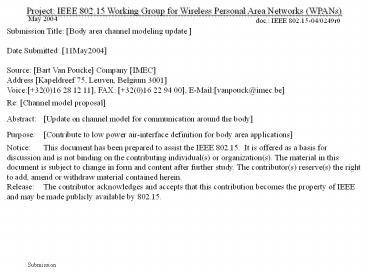Body%20Area%20Networks%20channel%20modelling%20update - PowerPoint PPT Presentation
Title:
Body%20Area%20Networks%20channel%20modelling%20update
Description:
... in this document is subject to change in form and content after further study. ... Future Work. Understand underlying mechanism responsible for results. ... – PowerPoint PPT presentation
Number of Views:66
Avg rating:3.0/5.0
Title: Body%20Area%20Networks%20channel%20modelling%20update
1
Project IEEE 802.15 Working Group for Wireless
Personal Area Networks (WPANs) Submission Title
Body area channel modeling update Date
Submitted 11May2004 Source Bart Van
Poucke Company IMEC Address Kapeldreef 75,
Leuven, Belgium 3001 Voice32(0)16 28 12 11,
FAX 32(0)16 22 94 00, E-Mailvanpouck_at_imec.be
Re Channel model proposal Abstract Update
on channel model for communication around the
body Purpose Contribute to low power
air-interface definition for body area
applications Notice This document has been
prepared to assist the IEEE 802.15. It is
offered as a basis for discussion and is not
binding on the contributing individual(s) or
organization(s). The material in this document is
subject to change in form and content after
further study. The contributor(s) reserve(s) the
right to add, amend or withdraw material
contained herein. Release The contributor
acknowledges and accepts that this contribution
becomes the property of IEEE and may be made
publicly available by 802.15.
2
Outline
- Body area UWB channel modeling strategy
- Simulation results so far
- Conclusion and Future work
3
Body area channel consists of a creeping wave and
scattered components.
- Creeping wave results from waves diffracting
around the body - This received signal is the creeping wave
combined with reflections off of nearby
obstacles.
4
We focus only on UWB communication around the
human body.
- We DO
- Develop a channel model only for waves
diffracting around the body - Use the Remcom FDTD simulator.
- We EXPECT
- To incorporate waves reflecting off of nearby
walls and obstacles, by combining our results
with other measurements made by the channel
modeling study group - Consider our channel model as a distinct cluster
arriving earlier than other clusters. - For LOS models replace the LOS component with
the creeping wave component in our model.
5
Waves travel through and around the body.
- EM waves propagate around the body via two
paths - Penetration (dielectric losses, tissues
interfaces losses) - Creeping waves (diffraction mechanism)
REMCOM XFDTD software together with a complete
body model
1 time step 10ps
6
We recorded the electric field around the body
for an UWB pulse
- Transmitted a 100 ps pulse using a simple 1.5 cm
dipole antenna. - The resulting pulse at a reference position 20
degrees from antenna was approximately a 1 ns
Gaussian pulse centered at 4 GHz. - All measurements made relative to this reference
position.
7
Path loss depends on angle separation between
antennas
8
Pulse is severely distorted by the human body.
90 Degree separation (with body)
Magnitude
Time
Magnitude
Time
9
Status and Conclusions
- We are simulating UWB communication around the
body using the Remcom FDTD simulator. - We propose re-using measurements done by this
study group to incorporate the influence of
surrounding walls and objects. - We are currently analyzing the results of our
simulations - We have recorded the path loss around the body
- We observed significant pulse distortion
10
Future Work
- Understand underlying mechanism responsible for
results. - Incorporate simulated results into a statistical
model suitable for communication system design
and comparison.































